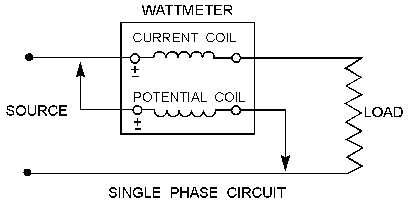3-26
impressed on the voltage circuit, current is proportional to and in phase with the line voltage. Figure 3-19
shows the proper way to connect a wattmeter into a circuit.
Figure 3-19.—Wattmeter connection.
Wattmeter Errors
Electrodynamic wattmeters are subject to errors arising from such factors as temperature and
frequency. For example, heat through the coils eventually causes the small springs attached to the pointer
to lengthen and lose tension, which produces deflection errors. Large currents through the wattmeter also
produce a noticeable deflection error. These errors are caused by the heat (I2R) loss through coils from the
application of high currents. Because of this, the maximum current range of electrodynamic wattmeters is
normally restricted to approximately 20 amperes. The voltage range of wattmeters is usually limited to
several hundred volts because of heat dissipation within the voltage circuit. However, the voltage range
can be extended by the use of voltage multipliers.
Good-quality, portable wattmeters usually have an accuracy of 0.2 to 0.25 percent. You must
remember, though, that electrodynamic wattmeter errors increase with frequency. For the higher
frequency and power ranges, special types of wattmeters are made specifically for those ranges. We will
discuss two such wattmeters in chapter 5 of this module.
Wattmeter Overloads
The wattmeter consists of two circuits, either of which will be damaged if too much current passes
through them. You should be especially aware of this fact because the reading on the instrument will not
tell you whether or not the coils are being overheated. If an ammeter or voltmeter is overloaded, the
pointer will indicate beyond the upper limit of its scale. In the wattmeter, both the current and potential
circuit may carry such an overload that their insulations burn; yet the pointer may be only part of the way
up the scale. This is because the position of the pointer depends upon the power factor of the circuit as
well as upon the voltage and current. Therefore, a low power-factor circuit will provide a very low
reading on the wattmeter. The reading will be low, even when the current and voltage circuits are loaded
to the maximum safe limit. The safe rating for each wattmeter is always distinctly rated, not in watts, but
in volts and amperes.

